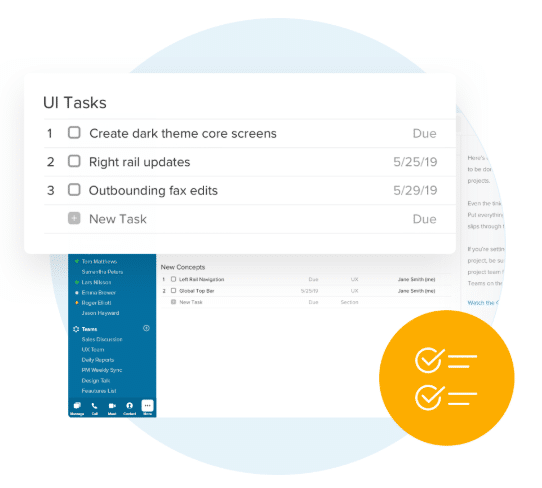At first glance, the term “collaborative leadership” may seem like an oxymoron. Leaders are supposed to be the decision-makers: they’re expected to make the right call when faced with tough choices—and by doing so, they’ll inspire employees.
So why should leaders collaborate if they’re in control?
Because in the end, lone-wolf bosses rarely succeed. Nobody wants to work under an overbearing manager who won’t listen to them.
According to Business Insider, the number one thing employees want more of from management is communication, and communication goes both ways. Using the right communication tools and listening to your employees (instead of just telling them what to do) could help you find key missing pieces and take your business to the next level.
But just listening isn’t enough: leaders need to ensure that they’re hearing from diverse and empowered employees. That’s what collaborative leadership is all about.
In this post, we’ll look at:
- What collaborative leadership is
- Why collaborative leadership is important
- 3 characteristics to look for in this type of leadership
- 6 ways to demonstrate collaborative leadership
🔑 Spoiler alert: a powerful communication tool is one key to better collaboration. Grab the free checklist to help you choose the right one for your business.
What is collaborative leadership?
Collaborative leadership is basically the alternative to siloed working styles. Instead of top-down management, a collaborative leadership style encourages access to information, different perspectives, and collective responsibility.
Managers who practice collaborative leadership tend to assemble diverse teams comprising different experiences and viewpoints. It’s well-known that there’s strength in diversity—and it’s better and more authentic to start with diversity as a key foundation of your business, rather than trying to incorporate it later on.
Even when working with people outside your business—freelancers or partners, for example—a collaborative leadership style can bring out the best in everyone involved. And working together remotely doesn’t have to get in the way of this: collaborative leaders just need to make the most of online tools to keep everyone aligned. (Here are a few tips for nurturing a collaborative culture.)
Why is collaborative leadership important?
Businesses benefit from different perspectives and employees who aren’t afraid to voice dissenting opinions. We’ve seen many examples of this—a commonly cited one (and cautionary tale) is Nokia, whose mobile division was bought out by Microsoft in 2013.
According to Harvard Business Review, Nokia’s long-serving executive team before the buyout was 100% Finnish. In addition, middle managers were afraid of being honest with their bosses. This unhealthy communication culture led to their homogenous leadership team not getting the information they needed, and in the end, Nokia was unable to compete with Silicon Valley’s innovation.
It’s hard to overstate the importance of diversity in business. Even one unorthodox idea can help build a better strategy, whether you’re trying to launch a new product, attract new clients, or beat a competitor.
But different perspectives will have only marginal impacts if they’re confined to their respective teams. To practice collaboration in the workplace, you need to foster communication between all parts of your business, and use the proper tools to do it. Even if your business is less than 10 people, opinions need room to thrive.
3 collaborative leadership characteristics
1. Open communication
As we mentioned above, communication needs to flow both ways. Make sure your employees are aware of business goals, and pay attention to their thoughts and ideas on how to meet and exceed these goals. A good employee engagement app will come in handy here.
2. Connection of ideas
Let’s say that two different employees, at different times, mention their interest in a particular initiative. Let them know they’re not alone—connect them with each other and encourage them to pursue it. This will show employees that you trust them, and it promotes the circulation of new ideas, which is essential to prevent stagnation.
3. Unification
Collaborative leadership requires a keen sense of balance. While employees need to be free to voice their opinions and make their cases, this kind of freedom can also create paralysis in an organization.
As the leader, it’s up to you to make the final call. Ensuring that perspectives have been shared will help you unify ideas into a cohesive strategy that’s been strengthened by diverse views.
How do you demonstrate collaborative leadership?
Good leaders lead by example. Preaching collaboration will be ineffective if your employees don’t see you living by it. For example, if you request your team to use tools in your collaboration hub, you have to use them regularly yourself. Here are six solid steps you can take to demonstrate collaborative leadership.
1. Set goals
This one may seem obvious. But you’d be surprised at how often employees feel misinformed about company goals. As the leader, it’s your job to set clear and actionable goals, and to communicate them to your employees. No matter which area employees work in, they need to understand how their efforts impact and contribute to the overall business.
2. Enable access to information
What’s the point in creating guidelines and roadmaps if your team doesn’t know where to find them? Whether it’s a task management tool like Asana or a team messaging platform that keeps everyone in sync like RingCentral, you need an easy way for your team to share information with each other.
A platform like RingCentral Office®, for example, offers task management for teams and projects, as well as easy file sharing. You can add tasks for yourself and your teammates right in your conversation threads in the app:
3. Be an active listener
When you’re talking to your employees, whether in a group meeting or a one-on-one, they deserve your full attention. Limit distractions: don’t pick up your phone or check your emails, and don’t interrupt your time with them. This applies to remote meetings, as well: in video calls, don’t start flicking through unrelated windows.
In the end, if your employees feel like you’re not fully present, they might not be comfortable expressing unique or controversial views—and those views might be exactly what you need to hear.
4. Encourage speaking up
Meetings are often dominated by extroverts. To demonstrate collaboration, it’s up to you to make sure everyone has their turn to speak. Quieter voices may need more encouragement, so ask around, promote healthy debate, and let the best idea win.
5. Avoid silos
As organizations grow, so do departments. It’s common for workers in larger companies to say things like “I have no idea what they do in ____.” So it’s best to tackle this issue from the beginning: get employees to work together as much as possible, and make them aware of what others are up to. This way, perspectives on different aspects of the business will course through the organization, and employees will feel better informed.
6. Turn failures into lessons
In any size organization, the blame game can create a toxic environment. If something doesn’t work, don’t waste time allocating blame or letting your employees scapegoat. Instead, try to create an open dialogue about what happened and why. Collaborative leadership emphasizes responsibility across the business, so it’s everyone’s job to learn from failure and build on it. “Each failure is an opportunity” may sound like a cliché, but that doesn’t make it any less true.
Build your collaborative leadership skills with the right tools
Collaborative leadership doesn’t just happen in-person anymore. You have to keep up with your team digitally, no matter where they’re located.
Find an all-in-one team video conferencing app (that ideally has voice calling and team messaging too) to help you and your team work closely together. This will give you the power to share goals, strategies, viewpoints, and files across any device in real time across borders and time zones.
Truly practicing collaborative leadership isn’t easy. You have to build a diverse team, empower your employees to speak up, strengthen cooperation between both individuals and groups, and learn from failure in a forward-thinking way—all while keeping debate healthy and productive. But the benefits of a collaborative leadership style are undeniable, and your colleagues will thank you for creating a trusting and constructive work environment.
Originally published Mar 01, 2020, updated Jun 18, 2024






